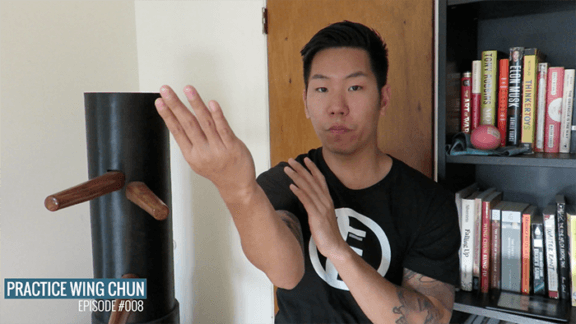Wing Chun Training with a Partner
Don’t Be Afraid to Get Hit When Training
Let’s talk about getting hit during training.

When I was a beginner, during Chi Sao, any time I got hit, I would freeze and stop.
I also thought getting hit meant I sucked because if I was getting better, I wouldn’t get hit and I’m supposed to be untouchable. At least, that’s what I thought.
Over time I realized that it happens to everyone including other students who are more senior than me. Now, I don’t think getting hit as a bad thing.
Here are 3 things you can focus on when getting hit:
- Why did I get hit?
- It was probably because I had an opening or gap somewhere.
- I need to figure out where it is and what was supposed to be there.
- Am I overreacting?
- When I try to block the strike, am I using both my arms efficiently or am I committing both arms to defend against one strike?
- I need to calm down and remember that I have two arms.
- Should I stop?
- Do I need to block this anymore or is it too late? If it already happened and I was hit, I can’t change that but I can move forward and work on changing the momentum.
- Changing my mentality from ‘getting hit means stop’, to ‘getting hit means keep going until I can no longer land a clean strike’.
When you get hit during training, don’t take it personally. Everyone is there to learn. Understand that getting hit is part of the training and part of the learning process.
Drop Your Defenses and Take the Hit
What?? Why would you do that?
Of course, I only mean in a controlled environment such as in class or with a training partner.
The reason for this type of training is to get into the habit of feeling a successful strike. As we’re training, we tend to lose sight of the objective for striking especially in Chi Sao when we go on the offensive and get into a routine of trying to land hits on our opponents without any real purpose other than trying to hit them.
When I started Wing Chun, I was taught to defend my centerline with Tan Sau, Bong Sau, or any technique I was taught to best defend myself in the situation. Defense is definitely important in Wing Chun but that’s only half of it.
Just as we’re drilled to defend, we should drill to know when we land a successful strike on an opponent. I believe it’s important, especially for people who are just starting Wing Chun, to train attacks and feel what a successful attack feels like so that we can develop good habits.
How can we train successful striking?
When you’re training with a partner, divide your drills so that one is striking and the other is taking the hits. Of course, don’t intentionally hurt your partner. If you’re striking, use light strikes to the chest or shoulders. Take turns switching roles with your training partner. After finishing your drills, resume normal training. Think of this striking drill as warming up and bettering your habits.
Try it out the next time you’re training and let me know how it goes!
Practice With Full Power Against Your Opponent
Let’s go over the safety practices with your training partner.
Practicing safely is important, especially in a class environment. When it comes to physical contact drills, where we attack our opponents, it’s important to remember that the goal is to practice what we learn and to NOT intentionally hurt our training partner.
Accidents do happen so I want to share 3 things that I’ve learned in class to practice striking my opponent safely.
- Attack the Shoulders (or anywhere below the neck) – The reason for this is because even a full blow to the shoulder doesn’t cause as much damage as it would to the face or the throat. The shoulders are also lined up to the height of the face so it helps with practicing how high to strike.
- Strike Past Your Opponent – This follows up on attacking the shoulders. If my striking arm can shoot past my opponent’s shoulders, it indicates a face shot because that means I was able to get inside my opponent’s space. If my opponent disagrees, I put my hand behind their neck to clinch them in to let them know that I, indeed, have control.
- Use Open Hand Strikes – Open hand strikes are great because it doesn’t bruise my opponent that easy and it’s also easier to recover from, in my opinion.
These are my 3 ways to strike safely.
As we get used to striking safely and controlling our strikes, we should work towards striking our opponent’s center because a full palm to the chest is equivalent to any strike to our opponent’s face.
Additional Notes
- Striking/punching power should come from the leg on the same side
- Punch and apply power at the last moment right at impact
Ultimately, the goal is to practice safe striking so that you don’t end up hurting your opponent by accident.
Mentality of a Junior and Senior Student
The thought process between junior and senior students are very different. When matched for training, a junior may use this chance to test their ability against their seniors. Meanwhile, a senior may not find practicing with juniors worthwhile because they’re not under pressure or learning something new.
I talk about my experiences as a junior and senior student in Wing Chun and the thoughts that goes through my mind when practicing with different levels of students in my class.


